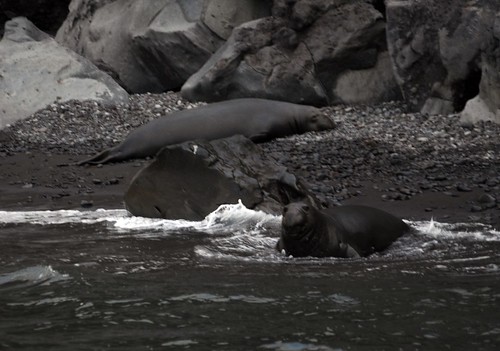So....I really hope this gets a seal of approval (heh) but Darren had a cool post up about [SPOILER ALERT] grey seals (which I've covered here before) that reminded me I owed you all some marine mammals (the ocean fans among you have put up with cycads, snakes and birds for a little too long). Accordingly the week's posts will all be marine mammals from our California trip.....
I figured I'd start with the biggest (of the pinnipeds, we also saw some fin whales) - the Northern Elephant Seal (Mirounga angustirostris). These shots were taken at Guadelupe island off the coast of Mexico and if anyone was wondering why Guadelupe has so many big sharks around it well, hey, you don't see waiflike models hitting the supersized mcd's too often do you? This is some serious shark food on the hoof/flipper!
I figured I'd start with the biggest (of the pinnipeds, we also saw some fin whales) - the Northern Elephant Seal (Mirounga angustirostris). These shots were taken at Guadelupe island off the coast of Mexico and if anyone was wondering why Guadelupe has so many big sharks around it well, hey, you don't see waiflike models hitting the supersized mcd's too often do you? This is some serious shark food on the hoof/flipper!

Northern elephant seals were, like many a marine mammal, hunted within a whisker of extinction for their blubber. In fact by the end of the 19th century there was only a single surviving rookery of between 100 to 1000 animals left in the entire world......and that rookery was, you've guessed it, on the shores of Guadelupe Island with its shark-infested surrounds. if you are on America's pacific coast at the right time of year nowadays there is every chance you'll see Northern Elephant Seals (there are 100,000 or so nowadays) as they've recovered well. Its worth remembering however that every elephant seal owes its life to a descendant making it ashore in these risky waters.

Its worth noting that this epic recovery isn't over yet though - the seals are currently increasing at 25% or so a year but a) a minimum population of 100 is a heck of a genetic bottleneck for a mammal species to pass through and b) they eat fish, something we're not doing a particularly good job of keeping around for the future. I believe the big one at the front, above, is a youngish male and the grey ones are females. I love the stripey look of the folds of fat and skin.
No comments:
Post a Comment